


Photo by Jim Pitts
Although hard to see, one of the German Königsberg guns, commanded by Bill Hamilton, is in the center village. Although supported by a German unit on its right, orders arrived for the gun to withdraw to prevent its possible capture.
Jackson Gamers' 20mm WWI in East Africa Game
The Initial battle
Our first game in this period - May , 2009
At the start of the Great War, confounding those who had hoped that the colonies of both sides could remain neutral while the home countries fought, the allies prepared to invade the German colonies in Africa. German Southwest Africa, Togo and Kameroon fell quickly to the invading allied powers.
In German East Africa things were different. Under the command of Colonel Paul von Lettow-Vorbeck, the Germans held out for years and even invaded the allied territories around them. Lettow-Vorbeck still had forces under arms and resisting when news of the end of the war came in November 1918.
This game, with Jay Stribling's 20mm armies are set in that period. We set up a screen between the two armies and each could set up anywhere on their side up to 18" in from the rear of the table.
The sequence of action is that players alternate having the initiative. The side with the initiative can have one command perform two actions. Possible actions are: Move, Fire, Resupply, or fight in close combat. Units (for example) may move then fire, or fire twice, or move and then fight in close combat.

Photo by Ed Sansing
Looking at the middle of the table from the German perspective. Ed Sansing's German infantry platoons and MG team are shown. In the immediate foreground is the overall German commander and two porters representing the battalion command post and the supply point from which porters carry water and ammunition forward to the individual platoons.

Photo by Ed Sansing
Bill Hamilton's big "Koernigsberg" gun is occupying the middle village. After firing just once we received orders (from the game-master in his persona as Von Lettow-Vorbeck) to withdraw the gun and it never fired again.
The SMS Koernigsberg was a German cruiser, which after a period of commerce raiding hid in the Rufi river delta while under repair. Located by British Aeroplances, she was hit and destroyed after several days of bombardment by 6" guns from two British light-draft gunboats, the HMS Severn and Mersey.
Several of the "Koernigsberg" guns were salvaged and placed on home-built gun carriages by the Germans. Of 10.4cm caliber they were the largest guns available to the Germans in the East African theater of operations. At least three of these guns still exist as museum pieces in Africa.
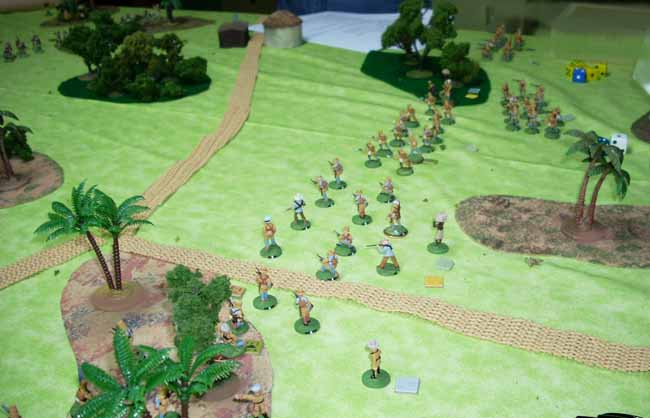
Photo by Ed Sansing
Looking at the German right, Bill Hamilton's units are in the foreground and Russ' in the background. Several of the units and officers have blank boardgame counters behind them. These have the officer's ratings on them - usually on the bottom so the enemy cannot gauge the caliber of the men fighting against them.
What were your objectives in this first game?
Each side had the same objectives. They were the two villages, the points where the trail left the table in the enamy's rear, and the German heavy gun. The Germans wanted to preserve (indeed, they wanted to USE it) and the British wanted to capture it.

Photo by Ed Sansing
One of Bill Hamilton's units (left) and Russ Schnieder's units (right) face off against Clay James and Sean Pitts. Phil Young's command is in the background to the right.

Photo by Ed Sansing
Bill Hamilton's schutztruppe is closest to the camera. Bill is facing units of the King's African Rifles facing Sean Pitts and Clay James. The "Koernigsberg" gun can be seen (barely) on the left of the image.
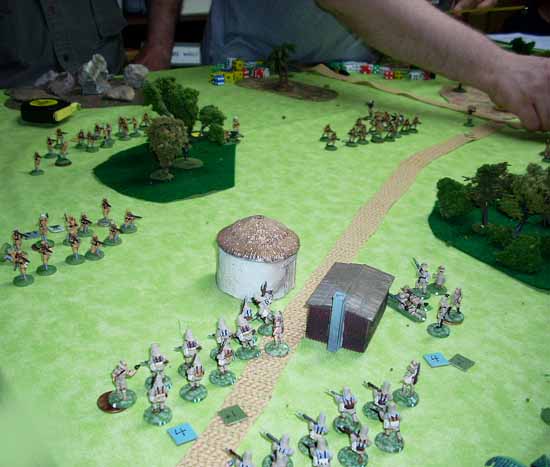
Photo by Ed Sansing
Looking at the battle from the British prospective. King's African Rifles under command of Phil Young (in the foreground) occupy the village and fire at Russ Schnieder's Schutztruppen.

Photo by Ed Sansing
Again from the British side. Sean Pitts' units backed by Clay are moving to the left toward the middle village, held by the Germans.
At the left of the image, oxen are hauling the "Koernigsberg" gun toward the German rear.
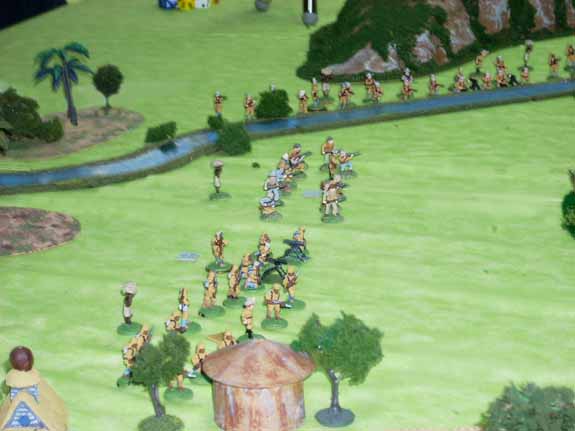
Photo by Ed Sansing
A long range look at Ed Sansing's Schutztruppen as they advance on the village. In the background one of Jim Pitts' infantry units fires from behind the river.
Who were the players in this First German East Africa Game?
The Germans were played by: Bill Hamilton, Russ Scheider, Jim Pitts, and Ed Sansing The British players were: Clay James, John Switzer, Sean Pitts, and Phil Young. Jay Stribling painted the troops and was the game-master for the game.
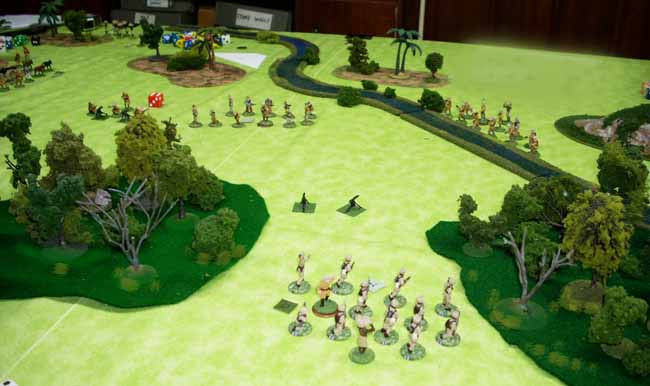
Photo by Ed Sansing
A look from John Switzer's position. Fire from Ed Sansing and Jim Pitts' infantry has either killed or driven off John's machine gunners, leaving their guns on the field.
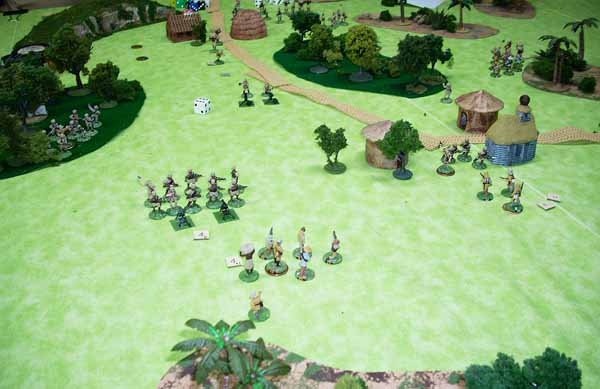
Photo by Ed Sansing
One of Clay's units has pushed what is left of Ed Sansing's infantry back out of the village. The remnants of Bill's command try and occupy the village but will soon be pushed back by Clay.
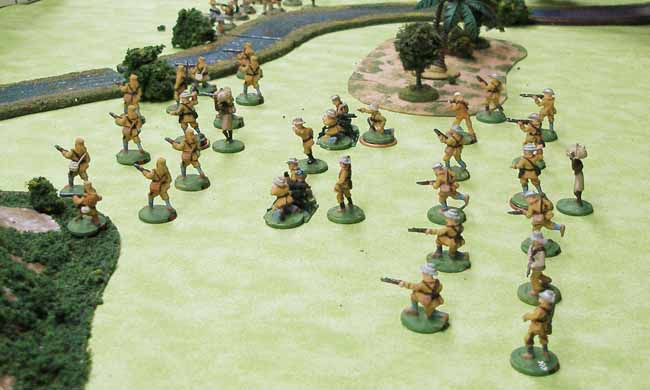
Photo by Jim Pitts
The field force commanded by Jim Pitts, composed of one unit of German schutztruppe and one unit of askari, plus two heavy machine guns, was deployed on the far left flank.

Photo by Jim Pitts
Another view of Jim's field force as it begins its advance. It is about to come to a stream on the left which it must cross. The stream will be under the fire of the British units and it has another unique class of defender.

Photo by Jim Pitts
In the British center, Clay James (closer hand) and Sean Pitts (blue shirt) advance their forces through and around one of the small villages. The players' hands give an idea of the size of the 20mm figures.
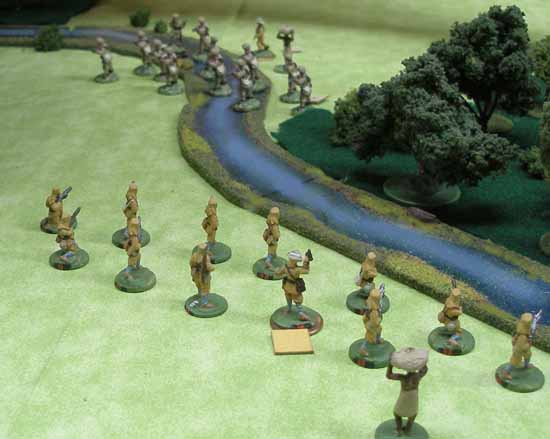
Photo by Jim Pitts
Jim's askari unit approaches an Indian unit commanded by John Schwitzer. In the next turn, aided by two heavy machine guns, Jim's askari wiped John's Indians out almost to a man.

Photo by Jim Pitts
Another shot of the central village showing the rear support of Ed Sansing's askari unit. Some of Russ Schneider's units can be seen at the upper right.

Photo by Jim Pitts
Jim's German unit has lined the stream and forced the Indian machine gunners to abandon their guns. The bearer to the rear of the German unit carries additional ammunition and water supplies.

Photo by Jim Pitts
After Bill withdrew the gun from the village, he attempted to hold it with an askari unit which was attacked by a British askari unit commanded by Clay James. The fighting here was at bayonet point and swayed back and forth for several turns.

Photo by Jim Pitts
Meanwhile, Ed Sansing is moving his German unit up on the flank of the village and his askari unit is moving up behind the village in support.

Photo by Jim Pitts
As Jim's askaris crossed the stream to envelop the British right flank, they were attacked by crocodiles (bloody game master and his poor die rolling!).
Although the askaris killed the crocs, they lost a man or two and were delayed in advancing behind the open British flank. By the time they could get themselves straightened out, the sun had set and the Germans were withdrawing from the field.
So, Who won this First battle?
The British won. They had a few more units but the German morale and the German heavy gun was supposed to balance that out. It did not.
The gun was so powerful that the game-master would not allow it to fire a second time. The British, by using a string of porters to supply their units with lots of ammunition, blew the Germans away.
Return to the Master Index of Photos and Games
Return to the Jackson Gamers' Homepage
Angelfire - Free Home Pages
Free Web Building Help
Angelfire HTML Library
htmlGEAR - free polls, guestbooks, and more!
Thank you for visiting The Jackson Gamers' pages at Angelfire. Please come back and visit again!